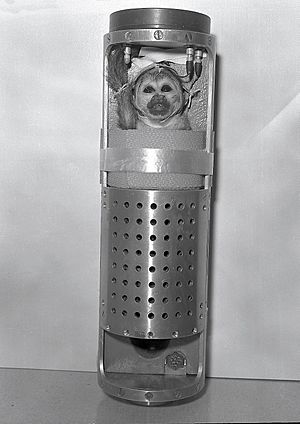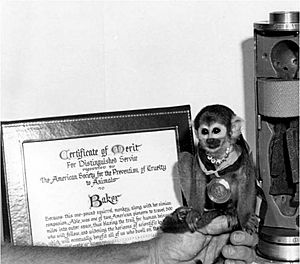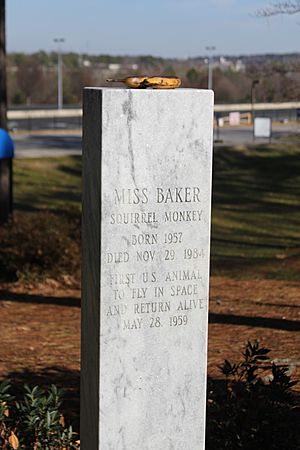Miss Baker facts for kids
Quick facts for kids
Miss Baker
|
|
|---|---|
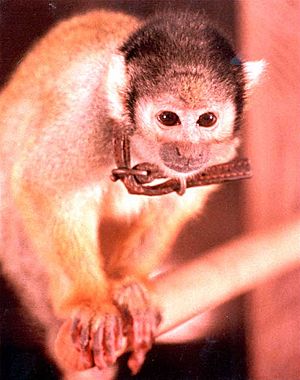 |
|
| Born | 1957 Iquitos, Peru
|
| Died | November 29, 1984 (aged 27) Auburn University clinic, Auburn, Alabama
|
| Resting place | U.S. Space & Rocket Center |
| Other names | TLC |
| Space career | |
| US Navy space pioneer | |
|
Time in space
|
16 minutes |
| Missions | Jupiter AM-18 |
Miss Baker (born 1957, died November 29, 1984) was a brave squirrel monkey. In 1959, she and another monkey, Miss Able, became the first animals from the United States to travel into space and return safely. Their journey helped scientists learn a lot about space travel for living beings.
Contents
Early Space Travelers
Before Miss Baker and Miss Able, other animals had flown into space. The United States had sent monkeys and mice on rockets. Sadly, some of these early flights did not end well for the animals. The Soviet Union also sent dogs into space. They were the first mammals to return safely from a suborbital flight in 1951. These early missions were important steps in understanding how living things would react to space.
Preparing for Space
Miss Baker was one of 26 squirrel monkeys bought from a pet shop in Florida. They were brought to a special school for naval aviation. Out of these, 14 monkeys were chosen for training. They had to get used to being in small spaces. They also had tiny sensors placed on their bodies to monitor them.
Miss Baker was special because she was very smart and calm. She also seemed to enjoy being handled gently. Because of this, she was given the nickname "TLC," which stands for "Tender Loving Care." Before their flight, the monkeys were given official names. Miss Baker was originally called "Bravo."
The Historic Flight
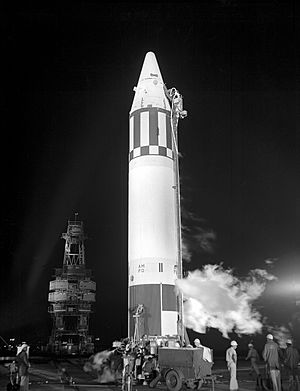
For her journey, Miss Baker wore a special helmet. It was lined with soft rubber and leather. She also had a small jacket and a device on her nose to check her breathing. She was placed inside a small capsule, about the size of a shoebox. This capsule was insulated to keep her safe. It had an oxygen tank and a system to remove the carbon dioxide she breathed out.
On May 28, 1959, at 2:39 in the morning, a Jupiter rocket launched Miss Baker and Miss Able into space. They reached an altitude of about 300 miles (480 km). The rocket accelerated very quickly, reaching 38 times the force of gravity. Their flight lasted 16 minutes. For 9 of those minutes, they experienced weightlessness, floating freely.
The rocket traveled about 1,500 miles (2,400 km) from Cape Canaveral to the Atlantic Ocean. A ship called the USS Kiowa recovered their capsule near Puerto Rico.
Miss Baker and Miss Able were not the only living things on board. The capsule also carried other small life forms. These included human blood samples, bacteria, onion and corn seeds, and even sea urchin eggs. Scientists wanted to see how space affected all these different things.
Sadly, Miss Able passed away four days after the flight. This happened during a surgery to remove the sensors from her body. Doctors said it was a very rare reaction to the medicine used for the surgery. Miss Able is now on display at the National Air and Space Museum.
Life After Space
After their successful return, Miss Able and Miss Baker became very famous. They even appeared on the cover of Life magazine!
In 1962, Miss Baker had a special "wedding" to another monkey named Big George. She lived at a medical center in Florida until 1971.
In 1971, Miss Baker moved to the U.S. Space & Rocket Center in Huntsville, Alabama. She became a popular attraction there. She loved to entertain visitors and received many letters from schoolchildren every day. Her birthdays were always a big celebration with balloons and her favorite foods, like cottage cheese.
Big George passed away in 1979. A few months later, Miss Baker "married" another monkey named Norman. She even had a little white wedding train, but she quickly tore it off!
Miss Baker continued to delight visitors with her energy. Her birthday was celebrated every year on May 28, the anniversary of her spaceflight. For the 25th anniversary of her flight, she received a rubber duck and her favorite treat: strawberry gelatin with bananas.
In 1984, Miss Baker passed away from kidney failure. She was 27 years old, making her the oldest living squirrel monkey at the time. She is buried at the U.S. Space & Rocket Center. Visitors often leave bananas on her gravestone as a tribute to her amazing life.
Images for kids
See also
 In Spanish: Miss Baker para niños
In Spanish: Miss Baker para niños


